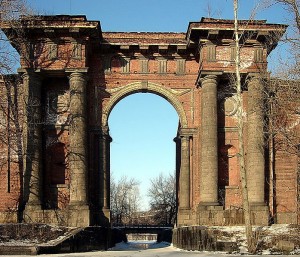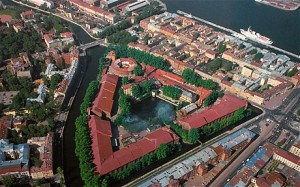Russian billionaire Roman Abramovich is only the latest visionary to have had a grand plan for Saint Petersburg’s New Holland Island. Will his be the one to ultimately succeed?
As far as beginnings go, that of New Holland Island was decidedly unglamorous. Centuries ago, it was merely another piece of the forested mainland lining the banks of the Neva River, the steel-gray seaway flowing from Russia’s northern lakes into the frigid waters of the Bay of Finland. It was along this thoroughfare that Saint Petersburg was founded in 1703; a city of floating islands, criss-crossed by the networks of icy canals built to support its shipping economy. In the early 18th century, it was two newly constructed canals – the Admiralty and the Kryukov – that created New Holland, a small triangular wedge at the border of the new city, named for the Dutch-style waterways that wrapped around it.

(Image Sourced from www.wikipedia.com)
The island was disregarded for decades; its owner, the Russian Admiralty, used it merely for lumber storage. In 1765, a renovation was in the making, and a prominent architect was commissioned to build a compound of red-brick warehouses. The final touch was the New Holland Arch, an imposing gateway flanked with massive Tuscan columns.
Until the 20th century, the island had a variety of utilitarian purposes, including a stint as a prison, a shipyard, and the site of Imperial Russia’s most powerful radio station. After the turmoil of the Russian Revolution, the island fell into disrepair – the red brick warehouses began to crumble and decay, and few had a reason to set foot on New Holland.

(Image Courtesy of the Telegraph UK)
However, the 21stcentury would usher in a new era of respect for the island – the introduction of capitalism set off a boom in the Russian economy that peaked in the mid-2000’s, and a variety of entrepreneurs set their sights on turning New Holland Island into a showpiece for Saint Petersburg. Apartment complexes, a shopping mall, a tourist attraction – many ideas were proposed.
The best known was a development under the artistic control of Norman Foster, lauded architect of many of London’s iconic office towers, which planned to transform the island into a luxurious enclave of glass-and-steel hotels, night clubs, and exclusive boutiques. But like many grandiose projects of the last decade, when the credit market collapsed, so too did its funding.
The latest hope for New Holland rests on the shoulders of Roman Abramovich, a self-made oil baron and the fourth-richest person in Russia. In December of 2010, it was announced that he had won a tender for the island, and at a price tag that has already hit US $400M, he intends to construct a spectacular museum and a complex of art galleries, a hotel, and office space.
Inspired by his girlfriend Darya Zhukova, a museum curator, Abramovich became an avid collector and could easily fill the museum from his own acquisitions, which includes numerous pieces by Lucien Freud, “Tryptich” by Francis Bacon, and a variety of cutting-edge artists from the modern era. From a simple shipyard to Russian high society, New Holland Island has certainly risen from its humble beginnings. Hopefully, this will be the idea that sparks a lasting transformation.
Read more about the island at: http://www.telegraph.co.uk/sponsored/russianow/features/8241788/Roman-Abramovichs-romantic-island-dream.html


